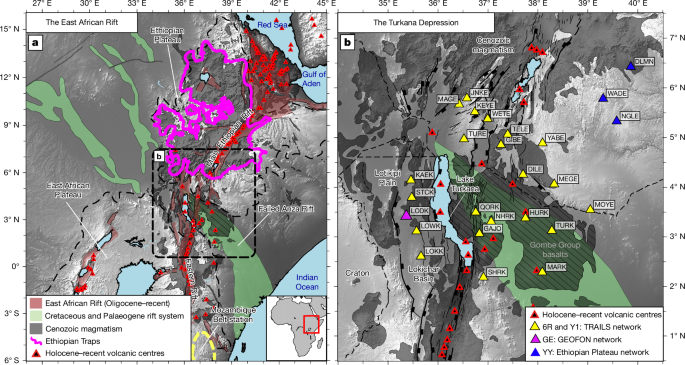The importance of past rifting in large igneous province development
Summary
This study uses seismic data from 38 broadband stations across the Turkana Depression and southern Ethiopia to map crustal and upper-mantle structure and to test how earlier rifting influenced later plume-driven magmatism. Joint inversion of Rayleigh-wave group velocities and P-to-S receiver functions yields 1-D shear-wave velocity and temperature profiles, Moho and lithosphere–asthenosphere boundary (LAB) estimates, and reveals sharp contrasts between the heavily magmatically modified Ethiopian Plateau and the adjacent, previously rifted Turkana Depression (including the failed Anza Rift). The key finding is that past rifting can make lithosphere more refractory (drier, depleted in fusible phases) and therefore more resistant to later plume-related thermo-mechanical modification — challenging the idea that pre-existing thin spots always localise flood-basalt magmatism.
Key Points
- The Ethiopian Plateau shows an 8–12 km thick lower-crustal intrusion layer and heavily modified, thin lithosphere; the Turkana Depression generally lacks comparable crustal magmatic modification.
- The failed Mesozoic Anza Rift remains seismically fast and refractory at mantle depths despite being a lithospheric thin spot at plume arrival time.
- Joint inversion (surface waves + receiver functions) provides robust shear-wave velocity and thermal profiles, allowing seismic and thermal LAB estimates (seismic LAB shallower than thermal LAB).
- Elevated asthenospheric temperatures (mantle potential T ≈ 1,400–1,450 °C) underlie the region, but being hot beneath a thin lithosphere does not guarantee large-volume magmatism if the lithosphere is depleted.
- Prior rifting can deplete volatiles and fusible phases (metasomes) from the lithosphere, increasing its resistance to later thermo-mechanical weakening and widespread intrusion.
- Implications extend to other magmatic passive margins: plate composition (fusibility/metasomatic state) can be as important as plate thickness in controlling magmatic rifted-margin development.
Content summary
The paper focuses on the Turkana Depression and neighbouring Ethiopian Plateau — two regions that experienced plume influence but show markedly different magmatic and lithospheric outcomes. Using 38 seismograph stations and a joint inversion workflow, the authors derive shear-wave velocity profiles to 400 km depth and convert mantle velocities to temperature using thermodynamic modelling. They identify the Moho and seismic LAB from velocity gradients and corroborate thermal LABs from geotherms.
Results show the Ethiopian Plateau has clear signatures of massive intrusive magmatism and a weak, modified lithosphere. By contrast, much of the Turkana Depression — notably the failed Anza Rift — retains thin crust and low bulk Vp/Vs consistent with melt-poor, mechanically stretched crust and a fast, refractory mantle lithosphere. Elevated asthenospheric temperatures are found beneath both areas, but only the plateau shows deep magmatic infiltration. The authors argue earlier rifting removed easily fusible phases and volatiles from the Anza lithosphere, making it relatively resistant to later plume heating and melt infiltration; rifting therefore can produce a stronger, less melt-prone mantle lithosphere rather than a weaker one.
Context and relevance
This work challenges a common paradigm in rift and LIP studies: that lithospheric thin spots inevitably act as weak zones that focus plume-driven magmatism. The paper provides observational seismic and thermal evidence that lithospheric composition (depletion/metasomatism) and prior thermal/magmatic history can control whether plume material produces widespread flood basalts and deep intrusions or instead feeds isolated, low-volume volcanism. That has direct implications for interpreting along-strike variations in magmatic rifted margins (for example, Atlantic margins) and for models of rift evolution and post-rift thermal subsidence.
Author style
Punchy — the authors make a crisp, evidence-backed case that past tectonic episodes can make a lithosphere less susceptible to later magmatic modification. If you work on rifts, LIPs or rifted margins, the details here matter for reconstructions and models of where magma goes and why.
Why should I read this?
Short version: it flips a neat assumption on its head. If you care about where big volcanic provinces form (or don’t), this paper saves you time by showing that thin = weak isn’t always true — history and composition matter. Good if you build models, interpret seismic images or try to predict magmatic budgets along margins.

